Complete Guide to Chickamauga and Chattanooga National Military Park in Tennessee and Georgia including history, things to do, nearby lodging and camping, and so much more.
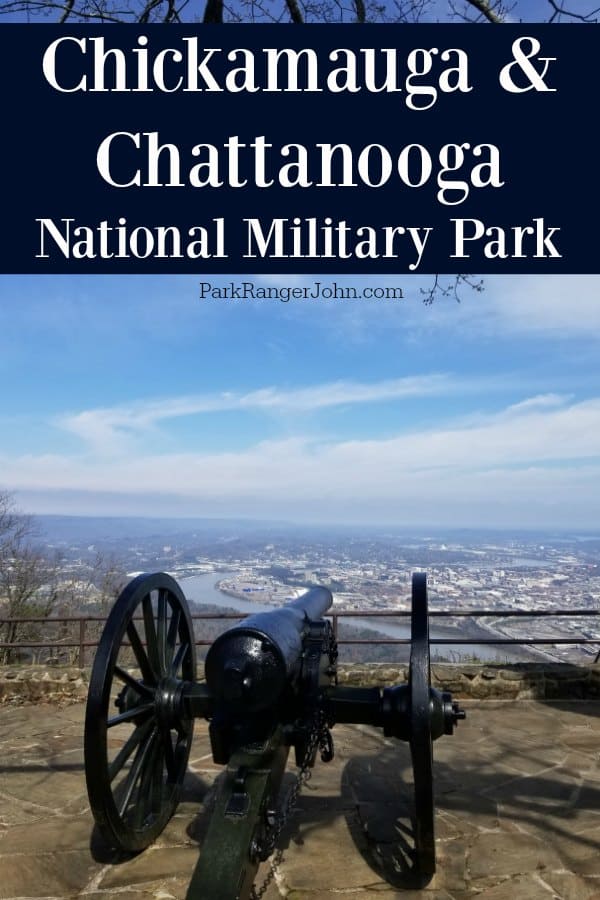
Chickamauga and Chattanooga National Military Park
The Chickamauga and Chattanooga National Military Park was the first of its kind in the country, it was authorized by the United States Congress in 1890. In 1895 it was dedicated and continues to serve as a historical and national military park.
About Chickamauga and Chattanooga National Military Park
The park spreads over nine thousand acres of various forests, urban landscapes, battlefields, and monuments. The park has six notable places in its area- Chickamauga Battlefield, Lookout Mountain Battlefield, Missionary Ridge, Moccasin Bend, Signal Point, and Orchard Knob.
You can learn more about the American Civil War and why this area was considered the gateway to the deep south.
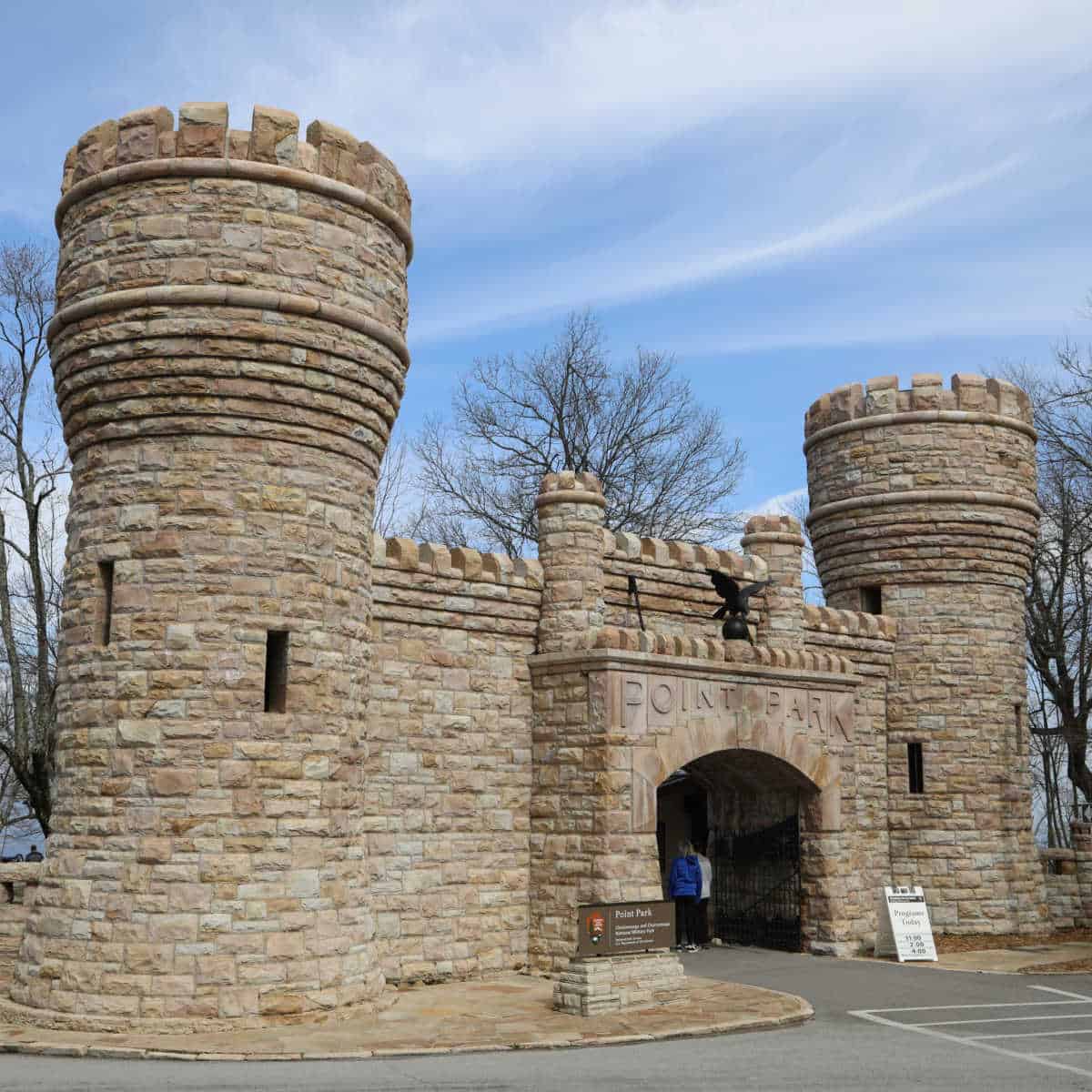
Is Chickamauga and Chattanooga National Military Park worth visiting?
If you have a passion for history, particularly the Civil War era, then a visit to Chickamauga and Chattanooga National Military Park would definitely be worth it. The park's stunning natural scenery provides wonderful opportunities for hiking and other outdoor recreational activities.
One travel tip I need to mention is this park can be heavy and hard to visit. We felt really somber during our visit and had to take time to really process all of the emotions this park brought up.
We have visited close to 300 parks in the National Park System and this park really weighed on us.
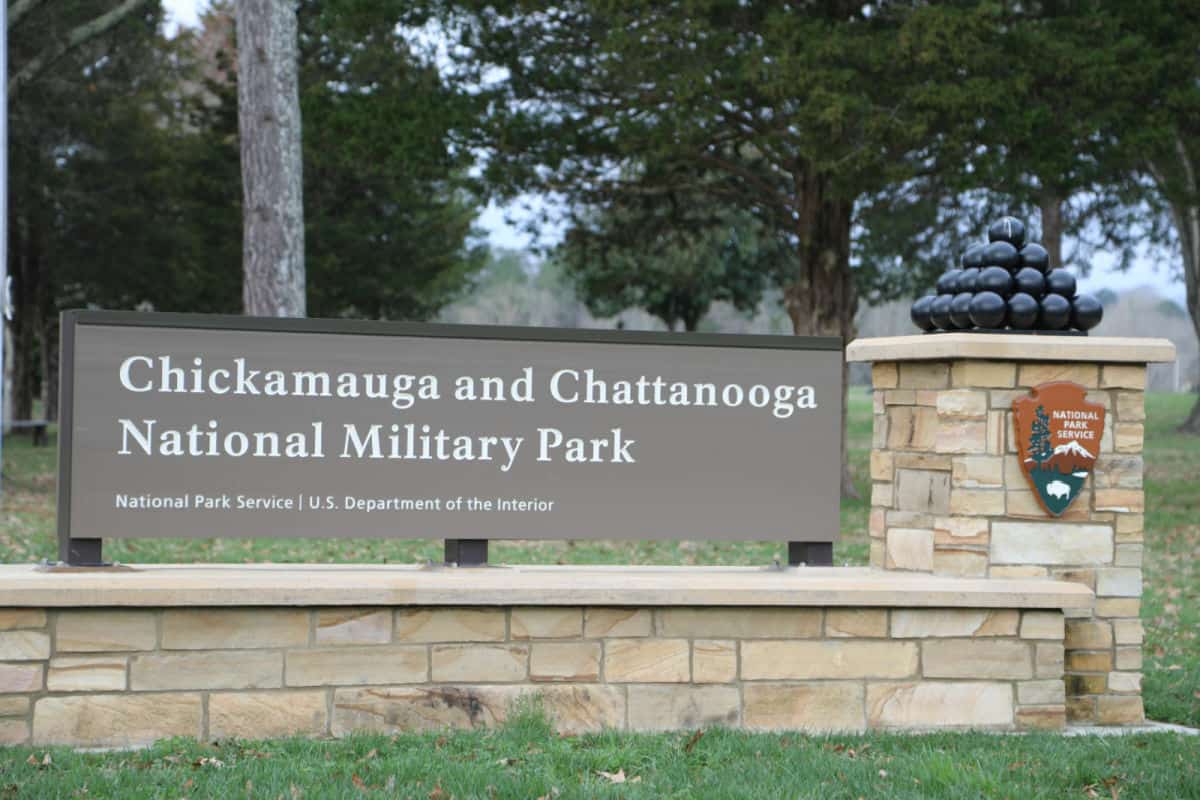
History of Chickamauga and Chattanooga National Military Park
The Chickamauga-Chattanooga National Military Park is where several key battles took place along the Chickamauga Creek over the control of the city of Chattanooga. These battles were between The Army of Tennessee headed by Maj. Gen. Braxton Bragg of the Confederates and the Union Army of the Cumberland, headed by General William Rosecrans. It was here that a Union blunder led to a Confederate victory.
Chattanooga was a strategic stronghold for the Confederates and was dubbed the gateway to the South. Chattanooga is located on The Tennessee River and was a railroad hub. The Union victory here meant they had a supply base that would allow Gen. Sherman to wreak havoc down to Savannah.
The Chickamauga Campaign
The Chickamauga Campaign began after the Confederates were pushed out of the city of Chattanooga by the Union. The campaign lasted until September 20th, 1863. The Chickamauga campaign ended with a Confederate victory at the Battle of Chickamauga.
The Union army under Gen Rosecrans misled the Confederate army into thinking that his forces would be attacking from above. Instead, they spread out and surrounded the city while Rosecrans advanced on Chattanooga from the rear. When Bragg realized what the Union army was doing, he evacuated Chattanooga and retreated into Northern Georgia.
General Rosecrans was so thrilled with his victory that he ordered his men to follow the retreating Confederate army. Bragg hoped that Rosecrans would interpret his evacuating Chattanooga as weakness, which he did. Bragg had hoped that Rosecrans would follow.
The Confederate Retreat
The Confederate army did not retreat far. The Confederate General planned to convince Rosecrans that his army was demoralized and weak after abandoning Chattanooga. So much so that some Confederate soldiers posed as deserters. Bragg wanted to use Rosecrans's dispersed army against them.
Bragg wanted to defeat the Union forces bit by bit, knowing that reinforcements were too far away to be of any help. Bragg attempted to trap and defeat a division of the Union Army under the command of Major General James Negley. However, the Confederate forces failed to act. Bragg was unpopular with his subordinates, so they made excuses when Bragg issued orders to attack the Union forces.
All the maneuvering of the Chickamauga campaign amounted to was a few skirmishes. Most significantly at Davis Cross Roads. After this, both General Rosecrans and Bragg decided to change tactics.
Rosecrans shifted from the offensive after the altercations at Davis Cross Roads and focused on bringing his dispersed forces back to Chattanooga. A Confederate offensive at Chattanooga would either force Rosecrans to come out and fight or make the Federals retreat from the city altogether.
The Battle Of Chickamauga
On September 19th, the Confederate and Union army faced each other in the woods on the banks of the Chickamauga Creek. The first day of the Battle of Chickamauga saw the Confederates attack the Union from the left, trying to break through the Union defensive line there, unsuccessfully. All this achieved was a high number of casualties on both sides.
On the second day, Braggs reinforced the Army of Tennessee with James Longstreet's army. The Confederate forces now outnumbered Rosecrans. Bragg split the troops and sent half heading left and half right.
On the Union side, General Rosecrans authorized a change in the defensive line. But, there was an error. Once the division left its position, no other division moved in. The result was that the line was left open and vulnerable. It was at this point that the Confederates made their move. The accidental gap in the Union defenses allowed the Confederates to breakthrough.
This blunder cost the Union the Battle of Chickamauga and forced them into a chaotic retreat.
The Chattanooga Campaign
Rather than pursue the retreating Union forces, Bragg failed to act and allowed them to retreat to Chattanooga. Rosecrans was in such a state of shock after the Union loss at Chickamauga that he did not do much when it came to the organization of troops, securing supply lines, or communications.
The Confederates laid siege to Chattanooga, occupying the high lying areas of Lookout Mountain and Missionary Ridge. The Confederates successfully cut off all supply lines into the city. Gen. Bragg aimed to starve the Union out and take back the city.
The Battle of Chattanooga
Given that Chattanooga was the gateway to the South, it was too important to lose control over the city. Rosecrans never recovered his senses after the loss at Chickamauga and wanted to evacuate Chattanooga when the siege started to take its toll. President Lincoln would not let that happen.
He relieved Rosecrans of his command and replaced him with Major General Ulysses S. Grant. Grant managed to open up a supply line, re-open communication lines and strengthen the city's defenses.
On November 23rd, Grant sent a division of troops to test the Confederate defense around the city. Thus began the three-day Battle of Chattanooga, with the Union pushing the Confederates further back. Grant's actions drastically turned the tide for the Union at Chattanooga.
In a battle known as the Battle Above the Clouds, the Union took Lookout Mountain from the Confederates. The Battle of Missionary Ridge was the Union's final push to drive the Confederates from the surrounding areas of Chattanooga.
The Union soldiers charged up the ridge forcing the Confederates to abandon their trenches and retreat and placing Chattanooga and its transportation and supply lines firmly under Union control by the 25th of November 1863.
The actions taken by General Grant during this period in the Chickamauga-Chattanooga National Military Park are often viewed as being one of the most significant military turnabouts in American history.
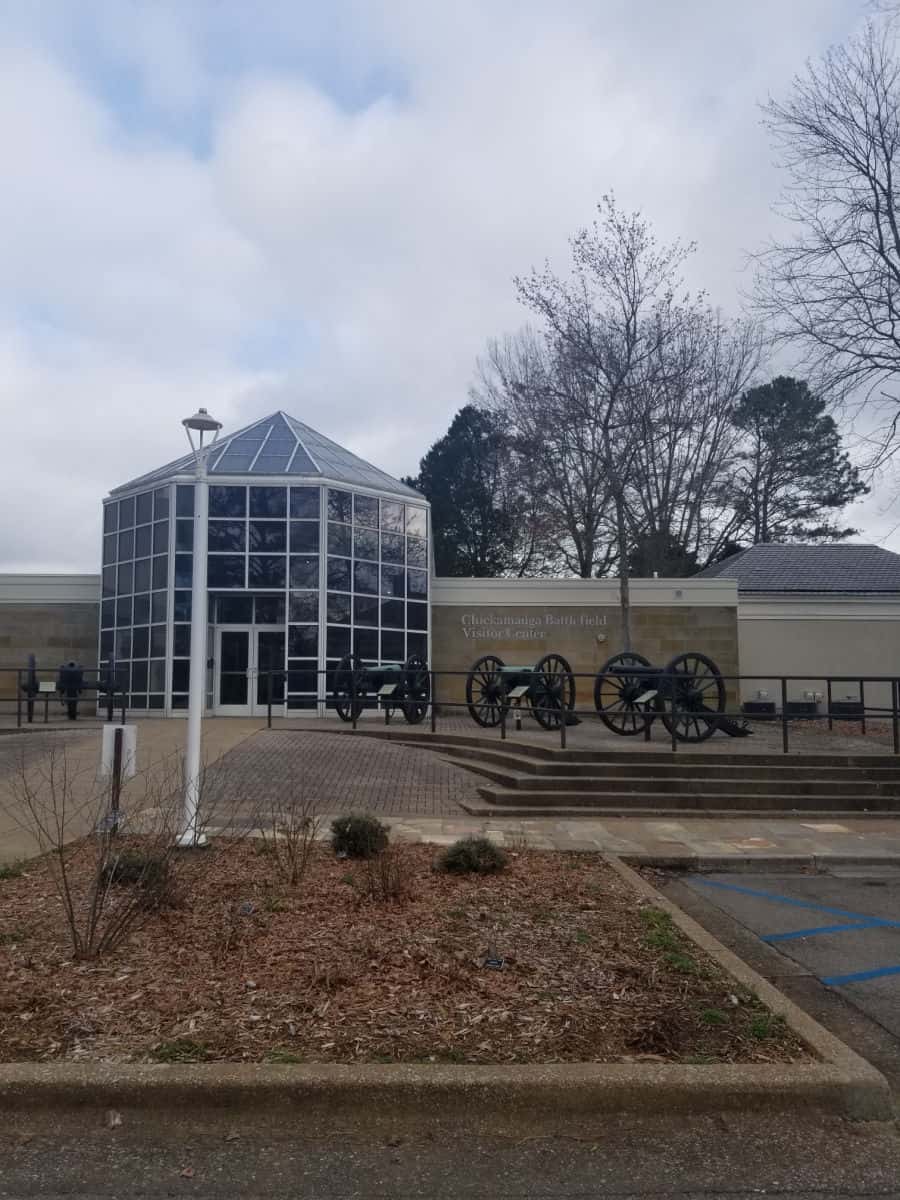
Things to know before your visit to Chickamauga and Chattanooga National Military Park
Entrance fee
Point Park (Lookout Mountain Battlefield) - $7.00
Annual Passes, Volunteer Passes, Senior Passes, and Access Passes are accepted at Point Park
There are no fees to visit other sites within the park
Learn more about National Park Passes for parks that have an entrance fee.
$80.00 - For the America the Beautiful/National Park Pass. The pass covers entrance fees to all US National Park Sites and over 2,000 Federal Recreation Fee Sites for an entire year and covers everyone in the car for per-vehicle sites and up to 4 adults for per-person sites.

Buy your pass at this link, and REI will donate 10% of pass proceeds to the National Forest Foundation, National Park Foundation, and the U.S. Endowment for Forestry & Communities.
National Park Free Entrance Days -Mark your calendars with the five free entrance days the National Park Service offers annually.
Time Zone
Eastern Time Zone
Pets
Pets are more than welcome in the park but they must be on a leash.
Only service animals are allowed in the park visitor centers (Chickamauga Battlefield and Lookout Mountain Battlefield - Point Park).
Cell Service
Most areas of the park have ample cellular coverage, although the signal can be periodically weak around Point Park on Lookout Mountain.
Park Hours
All units of Chickamauga and Chattanooga National Military Park are open during daylight hours, with the following exceptions: Chickamauga Battlefield Visitor Center and Lookout Mountain Battlefield Visitor Center are currently open 8:30 am to 5 pm, daily.
Visitor centers are closed Dec. 25 and Jan. 1.
Point Park main entrance opens at 8:30 am, daily.
US Hwy 27 Picnic Area, Wilder Brigade Monument, & Signal Mountain restrooms are closed Dec.1 - March 15.
Wi-Fi
There is no public Wi-Fi available
Insect Repellent
Insect repellent is always a great idea when outdoors, especially if you are around any body of water.
We use Permethrin Spray on our clothes before our park trips.
Water Bottle
Make sure to bring your own water bottle and plenty of water with you. Plastic water bottles are not sold in the park.
Parking
Chickamauga & Chattanooga National Military Park has several parking lots throughout the park. There are several spots for RVs and buses.
If you're looking for a place to park while enjoying some outdoor activities like hiking, jogging, or biking, utilize the recreation field parking lot located on the southern end of the battlefield.
Food/Restaurants
There are no restaurants within the park.
Gas
There are no gas stations within the park.
Drones
Drones are not permitted within National Park Sites.
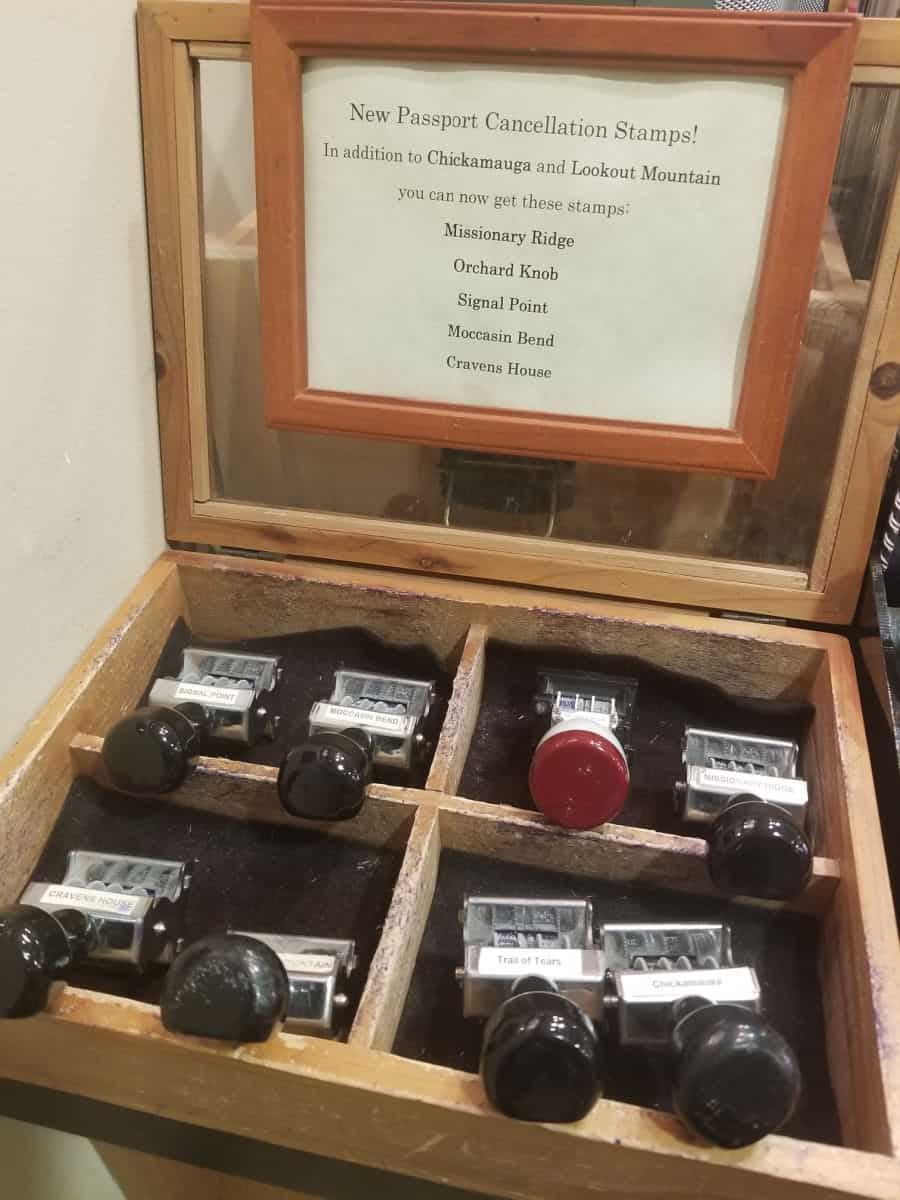
National Park Passport Stamps
National Park Passport stamps can be found in the visitor center.
We use the Explorer Edition Passport Book that can be expanded and updated. This is a great way to track all of the parks you have visited over time.
Make sure to bring your National Park Passport Book with you or we like to pack these circle stickers so we don't have to bring our entire book with us.
Chickamauga & Chattanooga NMP are part of the 1990 Passport Stamp Set.
Electric Vehicle Charging
There are about 17 Electric Vehicle (EV) charging stations within a 10 miles distance from Chickamauga and Chattanooga National Military Park
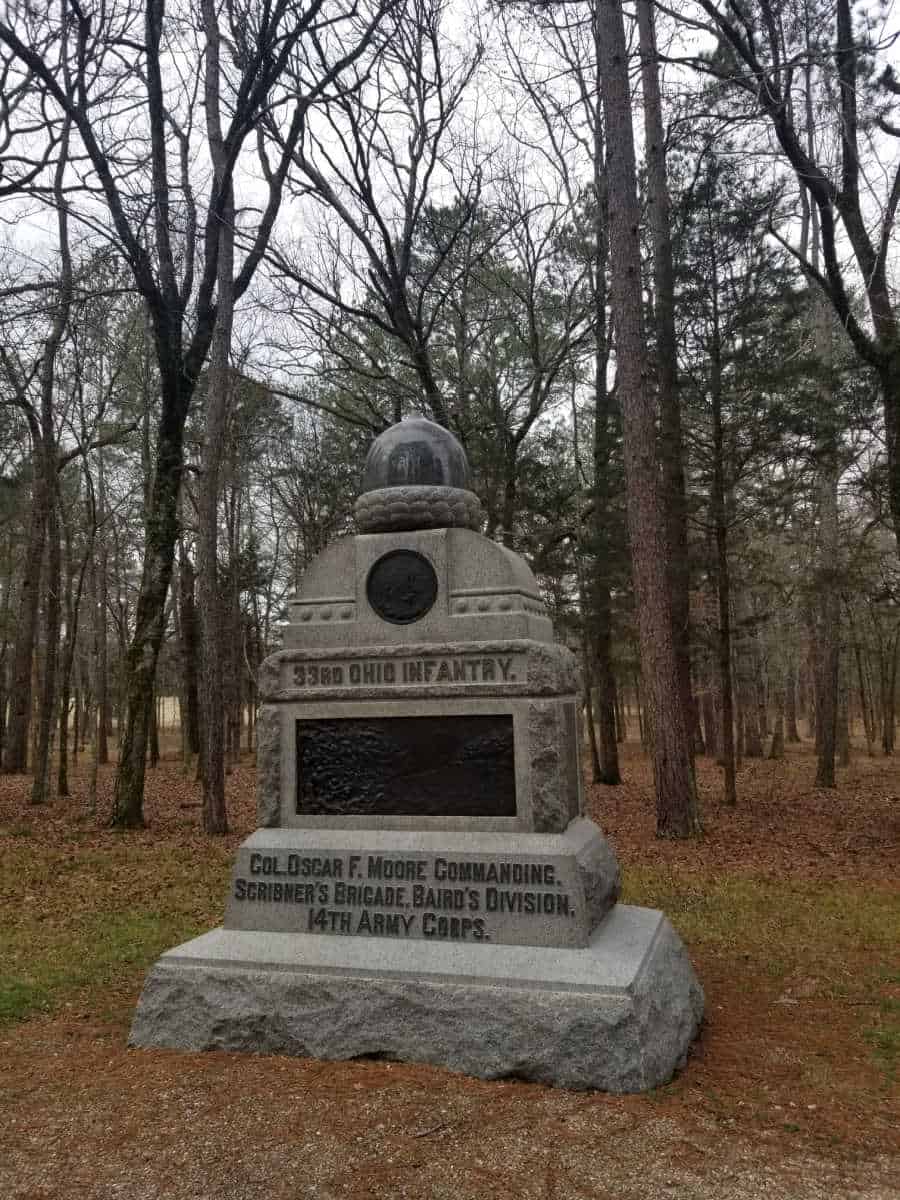
Details about Chickamauga and Chattanooga National Military Park
Size - 9,000 acres
Check out how the park compares to other National Parks by Size.
Date Established
August 19, 1890 - The first National Military Park established.
Visitation
In 2022, Chickamauga and Chattanooga NMP had 964,272 park visitors.
In 2021, Chickamauga and Chattanooga had 945,390 park visitors.
In 2020, Chickamauga and Chattanooga had 678,414 park visitors.
In 2019, Chickamauga and Chattanooga had 977,158 park visitors.
Learn more about the most visited and least visited National Parks in the US
National Park Address
3370 Lafayette Road, Fort Oglethorpe, GA 30742
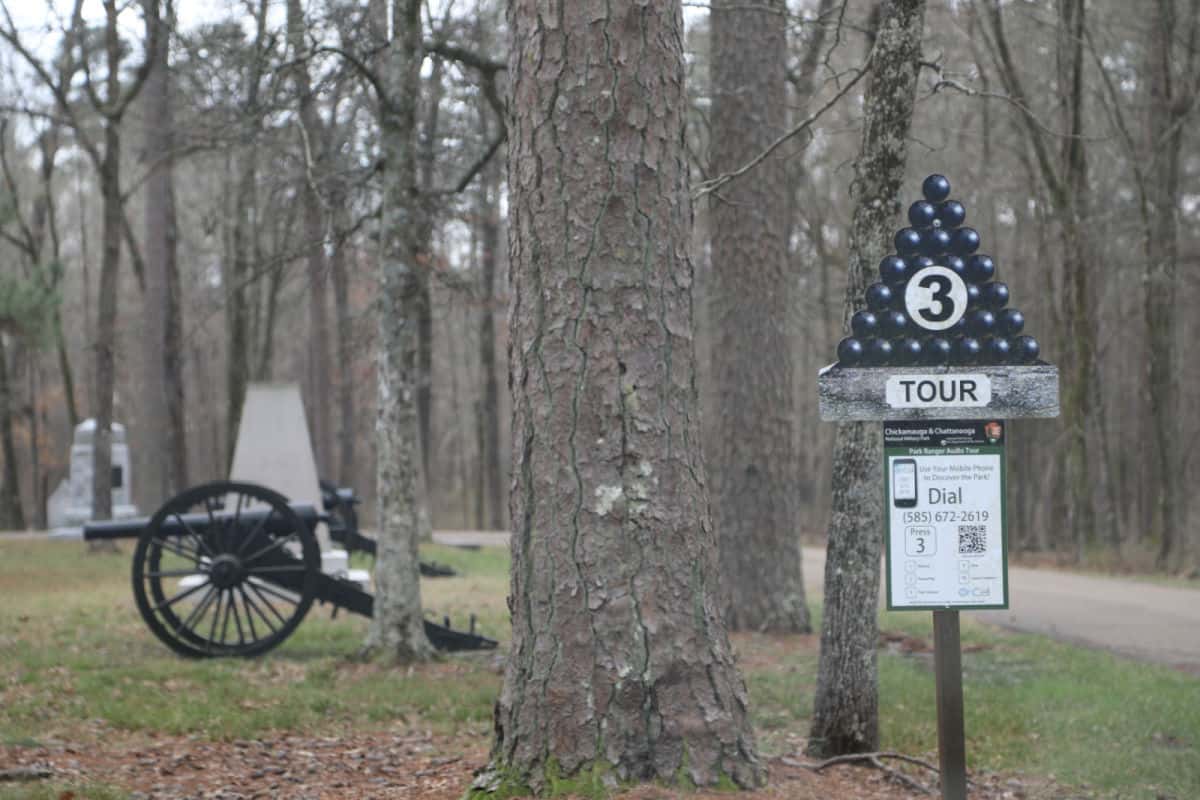
Where is Chickamauga and Chattanooga National Military Park ?
Chickamauga and Chattanooga National Military Park is located in Georgia and Tennessee, USA. It covers over 9,000 acres of land and preserves the sites of two major Civil War battles that took place in 1863.
Estimated distance from major cities nearby
Chattanooga, TN - 7 miles
Cleveland, TN- 367 miles
Dalton, GA- 38 miles
Rome, GA- 80 miles
Murfreesboro, TN- 101 miles
Knoxville, TN- 117 miles
Atlanta, GA- 123 miles
Nashville, TN- 134 miles
Huntsville, AL- 114 miles
Birmingham, AL- 163 miles
Estimated Distance from nearby National Park
Great Smoky Mountains National Park - 112 miles
Mammoth Cave National Park - 214 miles
Congaree National Park - 358 miles
Gateway Arch National Park - 439 miles
Shenandoah National Park - 472 miles
Where is the National Park Visitor Center?
Chickamauga Battlefield Visitor Center
3370 Lafayette Road, Fort Oglethorpe, GA 30742
The Chickamauga Battlefield Visitor Center is open daily from 8:30 am to 5 pm but is closed on Christmas Day and New Years Day.
GPS Coordinates for Chickamauga Battlefield Visitor Center: N34° 56.415 W085° 15604
Lookout Mountain Battlefield Visitor Center
110 Point Park Road, Lookout Mountain, TN 37350
Lookout Mountain Battlefield Visitor Center
GPS Coordinates for Lookout Mountain Battlefield Visitor Center: N35° 00.587 W085° 20.627
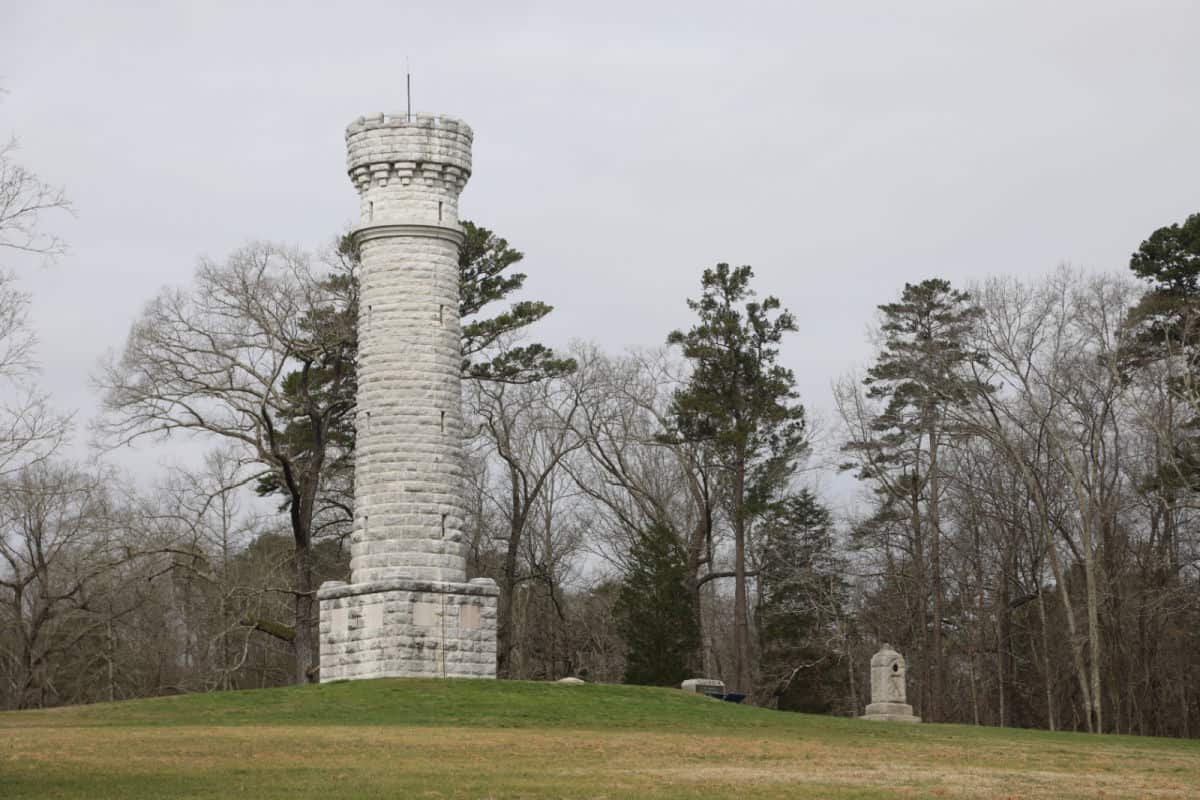
Getting to Chickamauga and Chattanooga National Military Park
Closest Airports
Chattanooga Metropolitan Airport (CHA)- 18 miles
Wilson Airport- 22 miles
Marion County Airport- 25 miles
International Airports
Huntsville International Airport -115 miles
Hartsfield-Jackson Atlanta International Airport-133 miles
Nashville International Airport- 134 miles
Birmingham-Shuttlesworth International Airport- 145 miles
Regional Airports
Tullahoma Regional Airport - 80 miles
Shelbyville Municipal Airport - 100 miles
Northwest Alabama Regional Airport -170 miles
Lawrenceburg- Lawrence County Airport- 149 miles
Driving Directions
From Interstate 75: At Exit 350 take Battlefield Parkway (Georgia 2) west to Fort Oglethorpe. Turn left at the intersection of Battlefield Parkway and Lafayette Road. Go one mile on Lafayette Road to the park entrance and visitor center.
From Interstate 24: At Exit 180 take U.S. Highway 27 south (Rossville Boulevard) to Fort Oglethorpe. At the intersection of Battlefield Parkway, continue straight through the intersection onto Lafayette Road to the park entrance one mile ahead.
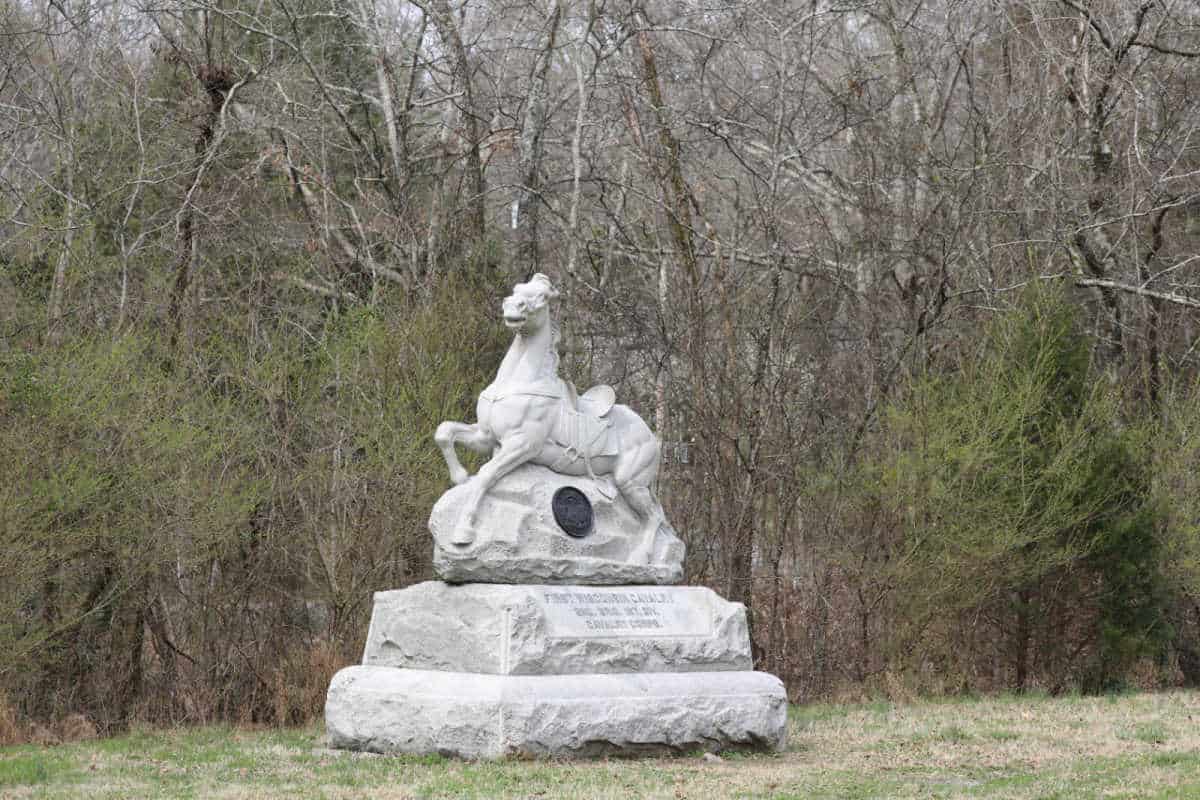
Best time to visit Chickamauga and Chattanooga National Military Park
While the park is open year-round we feel that the best time to visit is fall or spring when the weather is comfortable.
During the spring you can enjoy moderate temperatures and wildflowers. In the Fall the weather is cooler but the fall colors are amazing.
Weather and Seasons
The warmest weather is from June to August with average high temperatures ranging from the mid-80s to low 90 degrees.
The coolest weather typically occurs from December to February, when temperatures can average around 40-50 degrees during the day and drop below freezing at night.
The snowiest weather is from December through February. The average annual snowfall in the area is around 2-3 inches, with occasional heavier snowfalls possible during winter storms
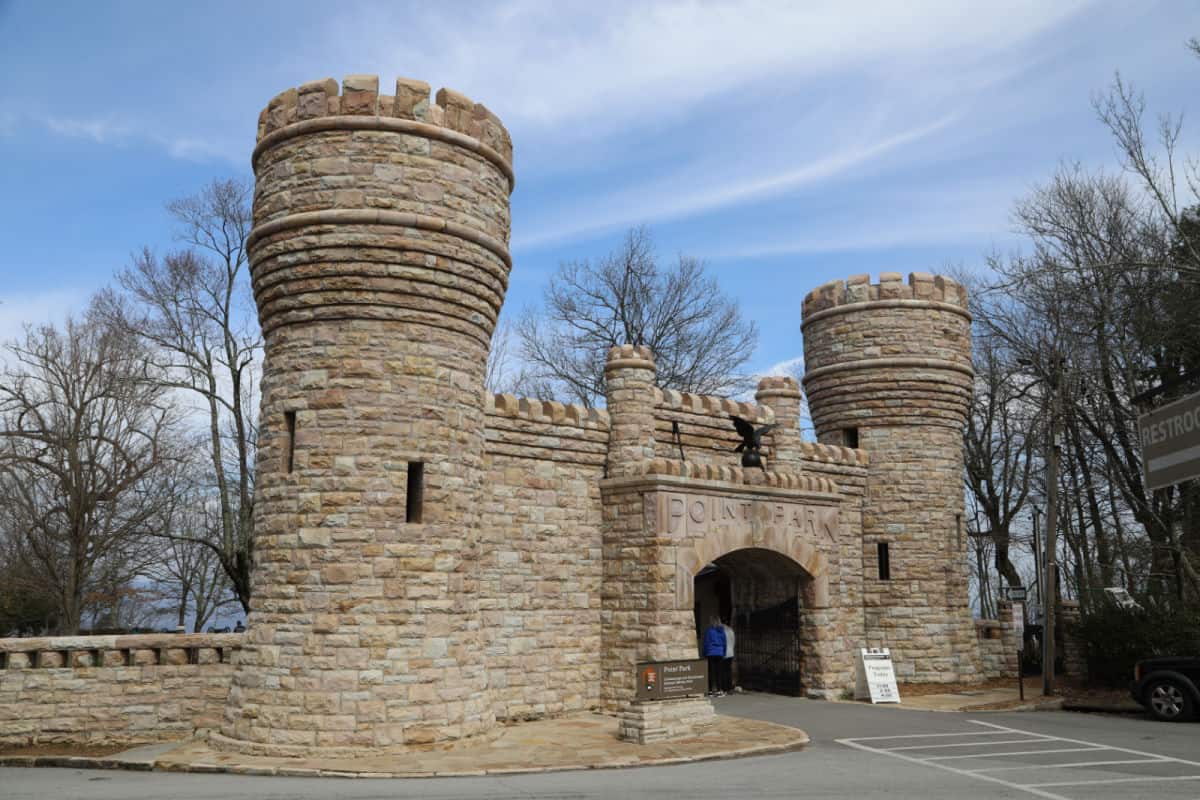
Important Locations with Chickamauga and Chattanooga NMP
Chickamauga Battlefield
The Chickamauga Battlefield Visitor Center is found at the northern end. Inside the Visitor Center, you will find a museum that exhibits the Battle of Chickamauga, the Fuller Gun Collection, and the Campaign for Chattanooga.
You will also find a bookstore that displays an orientation film every half hour. The Center is open daily from 8:30 am until 5:00 pm with the exception of being closed on Christmas Day and New Years Day.
The Union Army
The Union Army of Cumberland was led by General William Rosecrans in the summer of 1863. They moved from the middle of Tennessee and their objective was to capture the gateway of the Confederacy, Chattanooga. The Union Army came across Lookout Mountain in late September, they threatened General Braxton Bragg’s Confederate Army of Tennessee. This caused Bragg's Confederates to go towards Lafayette, Georgia.
From there it was more of a chasing game by both armies, like cat and mouse. On September 18, 1863, the Confederate army tried to cross West Chickamauga Creek but they were severely opposed. The Union cavalry had especially opposed at Alexander's Bridge and Reed's Bridge.
On the 19th of September 1863, a full-scale battle began. The Army of Northern Virginia and confederate troops which were reinforced by General James Longstreet began moving in from the East into the battle.
From the North, the Union reinforcements began to move in. The fight was terrifying as the units had to blindly attack each other due to the concealing of the troops by the wooded terrain.
During the course of the night, Bragg had reorganized the army. Bragg placed General James Longstreet in command of the left-wing, and General Leonidas Polk in command of the right-wing.
Initially, an early morning attack was planned but due to miscommunication, the attack happened at 9:30 in the morning. In this fight, President Abraham Lincoln's brother-in-law was killed, Confederate General Benjamin Helm.
The Cumberland Army also had their own miscommunications, regarding the placement of their troops. During the battle, General William Rosecrans gave conflicting orders to General Thomas Wood. General Thomas Wood began moving his troops North and out of line, which created a hole in the center of the Union army.
During this, the Confederates attacked and the right and center of the Union collapsed. On September 20, 1863, the Cumberland Army left the battlefield and re-joined the army to Chattanooga.
The battle was over for Chickamauga, leaving 35,000 men missing, wounded, killed and captured. The Confederates followed the Union Army to lay siege on Chattanooga.
The Union defeated the Confederates at Missionary Ridge, Orchard Knob and Lookout Mountain. They lost the battle of Chickamauga, but they won control over Chattanooga and they opened the gate to Confederacy.
Lookout Mountain Battlefield
Learn about the details of the blockade and the battles for control of Chattanooga. Exhibits can be viewed there and the historic 13 x 30-foot painting by James Walker, which is called The Battle of Lookout Mountain.
There are trails, monuments, battery positions, views and exhibits at Point Park which can be seen. Visit the center daily from 8:30 am to 5 pm, however, they’re closed on Christmas Day and New Year’s Day.
The Confederates pursued the Union Army
In September 1863, the Confederate Army pursued the Union Army to Chattanooga after their victory at Chickamauga. As the Union army prepared to defend, the Confederate army prepared to siege.
Between October and November, the Confederates went on top of Lookout Mountain to observe the Union Army so that they could be aware of their artillery positions. When it was late October, the Unions and Confederates clashed in the valley of Wauhatchie which is to the west side of Lookout Mountain.
The Union troops opened the supply route of the Cracker Line and on the 24th of November 1863, the “Battle Above the Clouds" began, as Union troops swept the slopes of Lookout Mountain to the north.
Thereafter, for the remaining period of the Civil War, Lookout Mountain was a famous tourist destination for civilians and Union soldiers. A studio was established by a photographer to take portraits of the soldiers at the location.
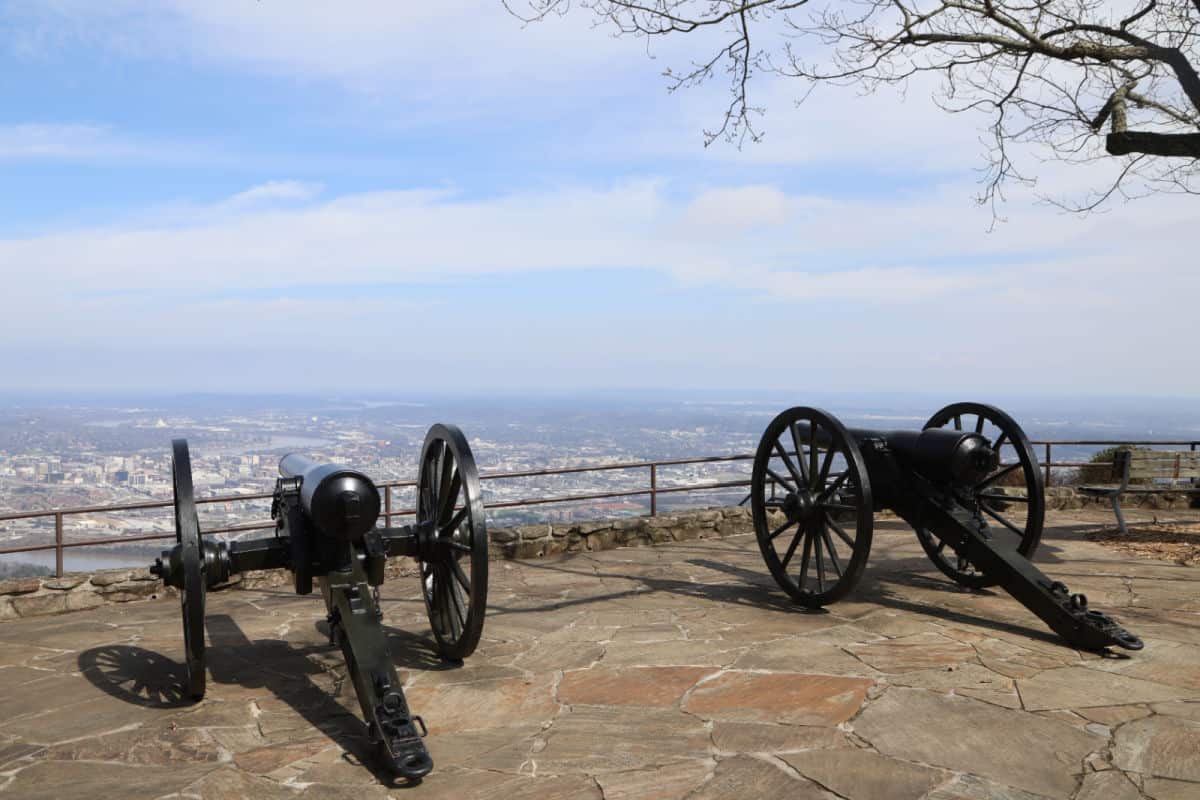
Point Park
Point Park offers epic views over Chattanooga, Tennessee! There are a few walking trails but our favorite was just relaxing on the benches and looking over the city.
Point Park Main Entrance Gate, atop Lookout Mountain, opens daily at 8:30 am.
Walking Tours of Point Park
Walk with a park ranger along the paved path around Point Park and learn about the history of Chattanooga and the park. These programs are offered daily at 11 am, 2 pm, and 4 pm. They typically last 30-45 minutes.
Lookout Mountain Battlefield Visitor Center
View exhibits and the historic 13- by 30-foot James Walker painting, THE BATTLE OF LOOKOUT MOUNTAIN.
Hours - 8:30 AM - 5:00 PM
The visitor center is closed Christmas Day and New Years Day.
Address: 110 Point Park Road, Lookout Mountain, TN 37350
We found parking behind the visitor center. There are also pay to park locations nearby.
Missionary Ridge
In the Missionary Ridge, you will find eight monuments and reservations that tell the key highlights of the story of the Battle of Missionary Ridge. Most of them are found in residential neighborhoods along a road the ridge's crest.
It is just asked of the public to respect the residents and not block the private parking or driveways, or entering private property without permission from the owner. The Missionary Ridge park properties are open from sunrise to sunset on a daily basis.
The eight monuments and reservations are; the Bragg Reservation, Iowa Reservation at Rossville, Turchin Reservation, Ohio Reservation, Phelps Monument, DeLong Reservation, 73rd Pennsylvania Reservation, Sherman Reservation and The New York Monument at Ringgold Gap, Georgia.
The Union Soldiers attacked the Confederate defenses
On the 25th of November, 1863, Union soldiers attacked the Confederate defenses which were along Missionary Ridge, the east of Chattanooga. There were over 50,000 soldiers and the attack started from the border of Georgia all the way to the end of Missionary Ridge.
The Confederate army began retreating towards Dalton and Chattanooga was in the Union’s hands. The eight monuments and reservations are found along the crest of the Missionary Ridge- they preserve to tell the key story of the battle.
Moccasin Bend
The Moccasin Bend is an archaeological district spanning over 12,000 years of human habitation. There are three ways to visit the Moccasin Bend, via the Gateway Site, the Blue Blazes Trail and the Brown's Ferry Federal Road.
The Moccasin Bend was used as a supply line
The Moccasin Bend has a rich history, 12,000 years worth. From 10000 to 8000 B.C, it was the Paleo-Indian Period. These were the first human inhabitant, the nomadic tribes moved here due to the resources in the valley.
From 8000 to 700 B.C, it was the Archaic Period. This was the beginning of the development of stone tools, these tools then assisted in establishing permanent villages on the Moccasin Bend.
From 700 B.C to 1000 A.D, it was the Woodland Period. This period best represented the Moccasin Bend as archeological excavations uncovered twenty sites of villages. This period is notably known for its beginning of agriculture and ceramic pottery.
From 900 to 1650 A.D, which was the Mississippian Period. During this period native people had a strong socio-political structure, built mound complexes and farmed larger tracts. Hernando de Soto or Tristan de Luna made contact with the village located in the bend, Hampton Place.
From 1838 to 1839, Cherokees were rounded up and put in deportation camps to be removed to Oklahoma. One of the camps were located near Chattanooga, at Ross' Landing. Groups of Cherokees that left Ross' Landing traveled to Oklahoma by water and they passed the Moccasin Bend. The removal of the Native Americans to the West was named the “Trail of Tears".
From 1830 to 1850, the Brown’s Ferry Road was used for the antebellum slave trade, people were enslaved on farms in the Moccasin Bend. During the battles and siege that took place in 1863, the Union and Confederate troops exchanged fire on Lookout Mountain. The peninsula was used by the Union soldiers as the main supply line, called the “Cracker Line".
Signal Point
Signal Point is an access point to the Cumberland Trail and is a popular destination for hiking and has magnificent views of the Tennessee River. Signal Point is located on the Signal Mountain and is at the end of the Signal Point Road. You will find parking available and the restrooms are made available seasonally in fall, summer and spring.
Signal Point was a communication point by Union soldiers
The Cumberland Plateau has two mountains, Signal Mountain which is northwest and Raccoon Mountain which is west of Chattanooga. Signal Point is found on Signal Mountain and it overlooks the Tennessee River, which is between both the mountains.
During the besiege of Chattanooga, Signal Point was the only high ground area that was controlled by Union troops. They used it as a communication point with the outside world by using a signaling system along the river. This happened between September and November in 1863. When Union forces opened the supply line on the 27th of October, 1863, to the city via Brown's Ferry, the communication point was mainly used for the reporting and observing of the Confederate troop.
Orchard Knob
Orchard Knob is the size of a city block and it can be accessed to the hilltop by four sides. Some of the sides are paved but others have high grass.
You will find parking on the street. The climb to the top is short but is a very steep one. Atop you will find five monuments, there’s also tablets and artillery, each dedicated to the Illinois troops- New Jersey, New York, Maryland, and Wisconsin.
The battles for Chattanooga took place here
Battle lines were formed under the command of General George. H Thomas in Orchard Knob on 23rd of November, 1863. They were formed between Chattanooga and Orchard Knob, which is a rocky mound.
The Confederate soldiers had already prepared themselves around the base by constructing rifle pits which would assist them in the besieging of Chattanooga. In the afternoon, 14,000 troops of Confederate soldiers went to their positions, only 634 remained to hold the line around Orchard Knob.
The Orchard Knob was closed in by Union soldiers which began to exchange fire with the Confederate soldiers. It was a minor engagement, but it showed Ulysses S. Grant that the opposing army was a very capable fighting force. But it also showed Bragg that he should be concerned about the Union attack. On the 25th of November, Orchard Knob had become Grant's observation post, as he watched the assault by the Union soldiers on Missionary Ridge.
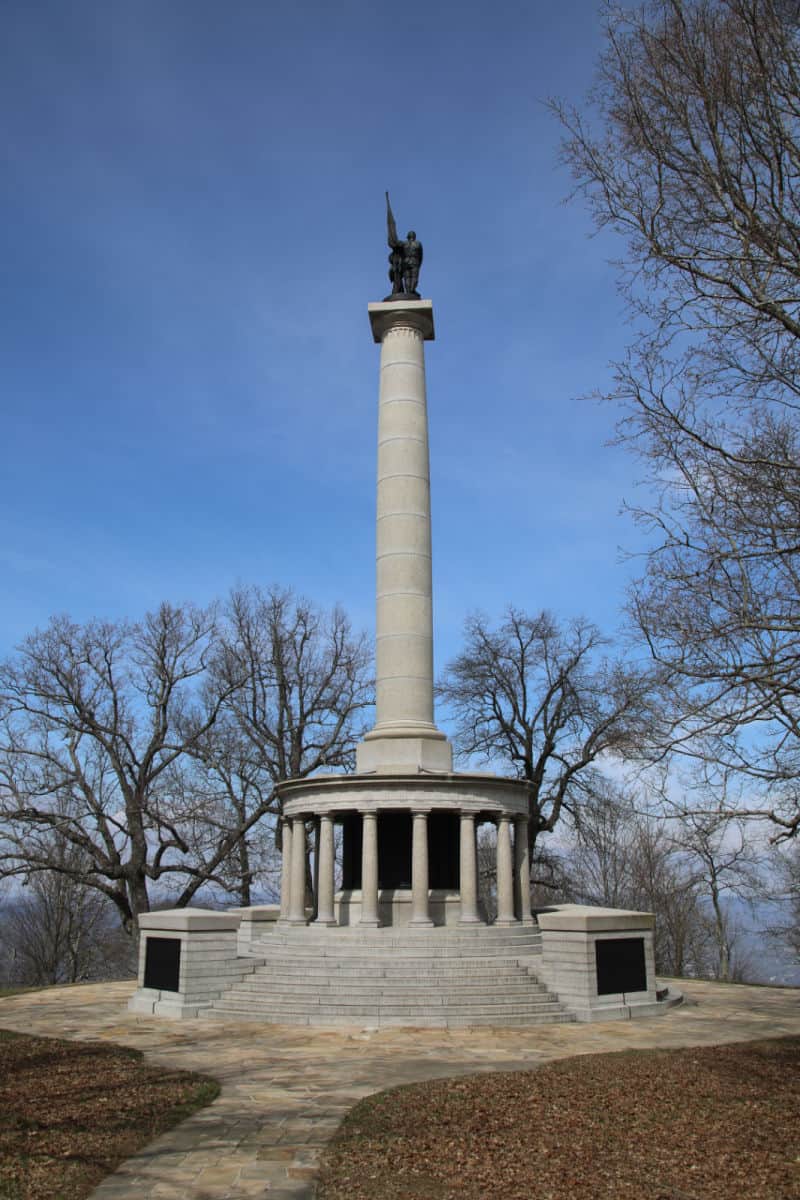
Best Things to do in Chickamauga and Chattanooga NMP
There are quite a few things to do in Chickamauga & Chattanooga National Military Park! We suggest planning out your route and your top sites you don't want to miss before heading to the park.
Plan a few hours at each stop to make sure you have time to explore and see everything.
Visitor Center
The visitors center includes a gift shop, volunteers available to answer questions about Chickamauga & Chattanooga, information on upcoming events, information on major points of interest in the park you don't want to miss, and so much more!
Cell Phone Tour
There’s a self-guided cell phone tour that is utilized by many of the visitors.
There are eight locations around the battlefield where visitors can call and there would be a narration of the battle action that took place in a certain area.
Junior Ranger Program
There are two Junior Ranger programs available, 2nd grade and younger, and one for people in 3rd grade or older.
You can get a copy of the Junior Ranger book at either the Chickamauga Battlefield Visitor Center or the Lookout Mountain Battlefield Visitor Center.
The Junior Ranger program includes visiting both Chickamauga Battlefield and Point Park at the Lookout Mountain Battlefield.
This is a Junior Ranger program you are going to want to plan on spending a few hours on.
Ranger Guided Tours
There are also Ranger-Guided tours throughout the year. Check the park’s calendar for current tours.
Living History Programs
Living historians will present programs on life in Civil War armies at the time of the Battle of Lookout Mountain including musket demonstrations.
Fridays, Saturdays, and Sundays at 10:30am, 11:30am, 1:30pm, 2:30pm, and 3:30pm
Cravens House
Cravens House is open for a tour from 1 pm to 5 pm on Saturdays and Sundays, depending on staff availability.
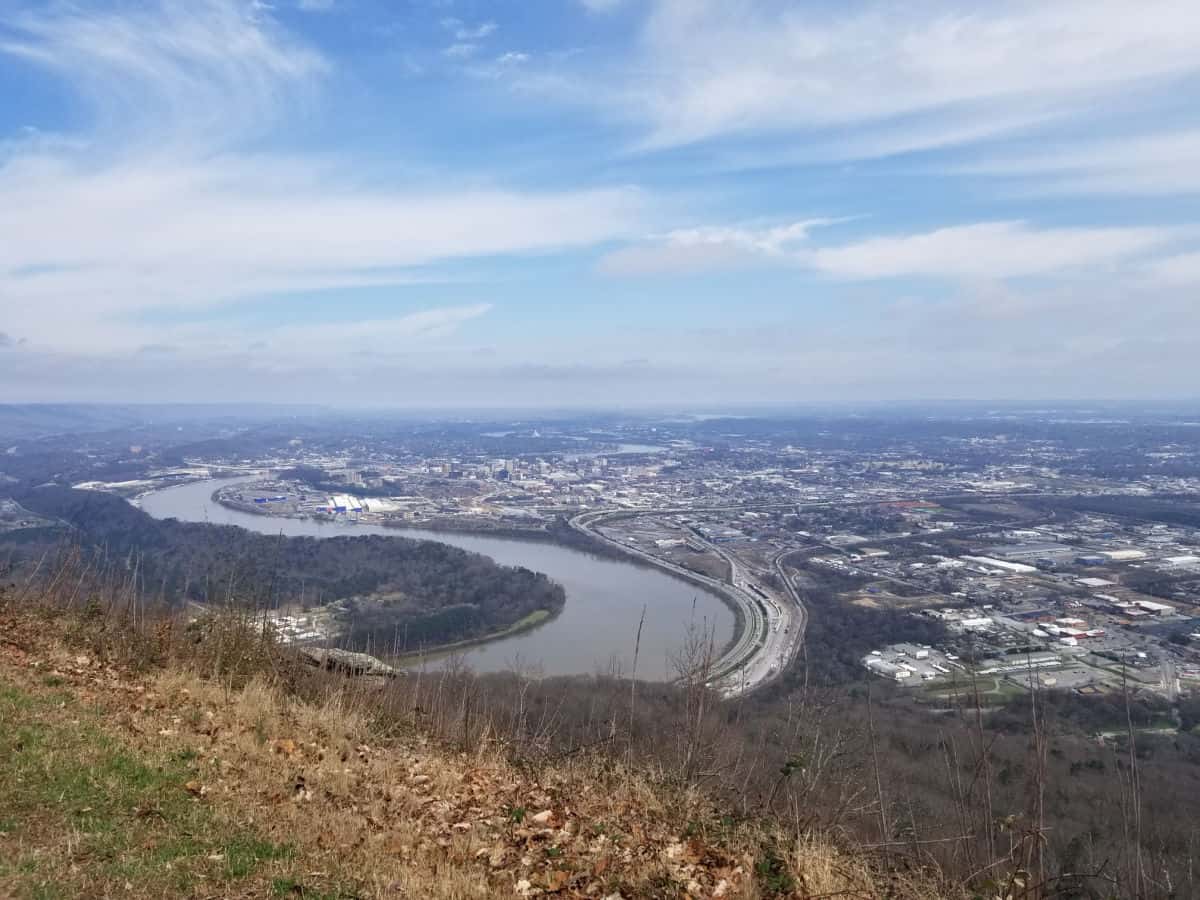
Hiking in Chickamauga and Chattanooga National Military Park
Always carry the 10 essentials for outdoor survival when exploring.
There are five hiking trails at Chickamauga Battlefield. There are also dozens of hiking trails that wind up and down Lookout Mountain.
How to beat the crowds in Chickamauga & Chattanooga NMP
If you're planning on visiting and want to avoid the crowds, consider visiting during the off-season months like spring, fall, or winter. These times of the year tend to be less busy compared to the peak summer months.
Another tip is to go early in the day. If you arrive at the park when it opens, you can beat the crowds that usually show up later in the day. If you have the option, try visiting during the weekdays instead of weekends. There are usually fewer visitors during the weekdays, making it an excellent time to explore without the crowds.
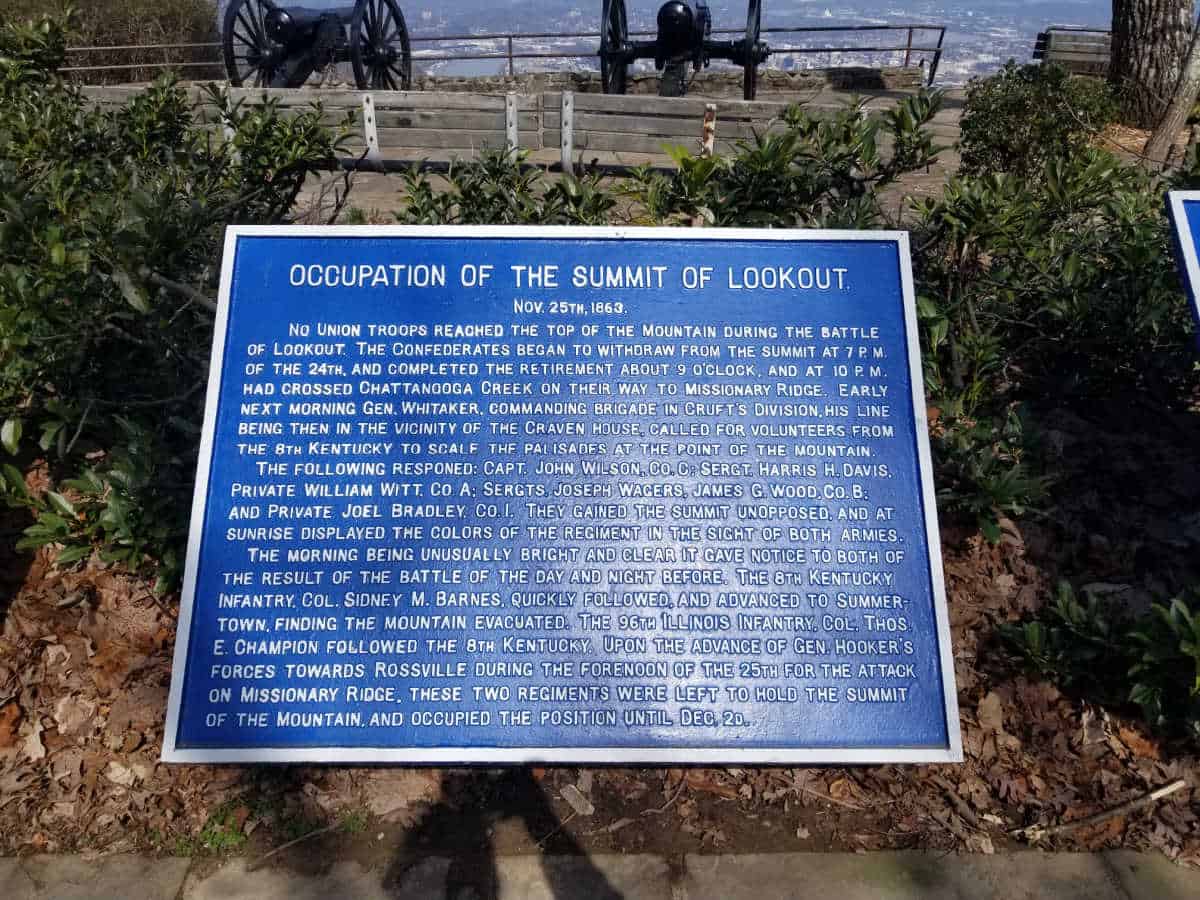
Where to stay when visiting
There are no National Park Lodges within the park.
Super 8 by Wyndham - is a budget-friendly hotel located in Fort Oglethorpe, Georgia. The hotel offers simple, clean rooms with free Wi-Fi, flat-screen TVs, mini-fridges, and microwaves. The hotel provides guests with complimentary continental breakfast, an outdoor pool, and free parking.
Baymont by Wyndham- The hotel features a variety of amenities including complimentary breakfast, free Wi-Fi, an outdoor pool, a fitness center, and guest laundry facilities. The rooms are equipped with a flat-screen TV, microwave, mini-fridge, coffee maker, and a work desk.
Chickamauga Country Cottage- This charming cottage is fully furnished with a living room, dining room, fully equipped kitchen, two bedrooms, and one bathroom. Outside, there is a spacious deck where you can relax and enjoy the peaceful countryside setting.
Fairfield Inn & Suites by Marriott- It offers comfortable and affordable accommodations to guests traveling for business or leisure. The hotel features 79 rooms and suites with modern amenities, such as free Wi-Fi, flat-screen TVs, mini-fridges, microwaves, and coffee makers. Guests can also enjoy free hot breakfast, fitness center, indoor pool and hot tub, and on-site parking.
Click on the map below to see current rates for hotels and vacation rentals near the park.
Camping
There are no campground within the park.

For a fun adventure check out Escape Campervans. These campervans have built in beds, kitchen area with refrigerators, and more. You can have them fully set up with kitchen supplies, bedding, and other fun extras. They are painted with epic designs you can't miss!
Escape Campervans has offices in Vancouver, Seattle, Portland, San Francisco, Las Vegas, Los Angeles, Phoenix, Salt Lake City, Denver, New York, and Orlando
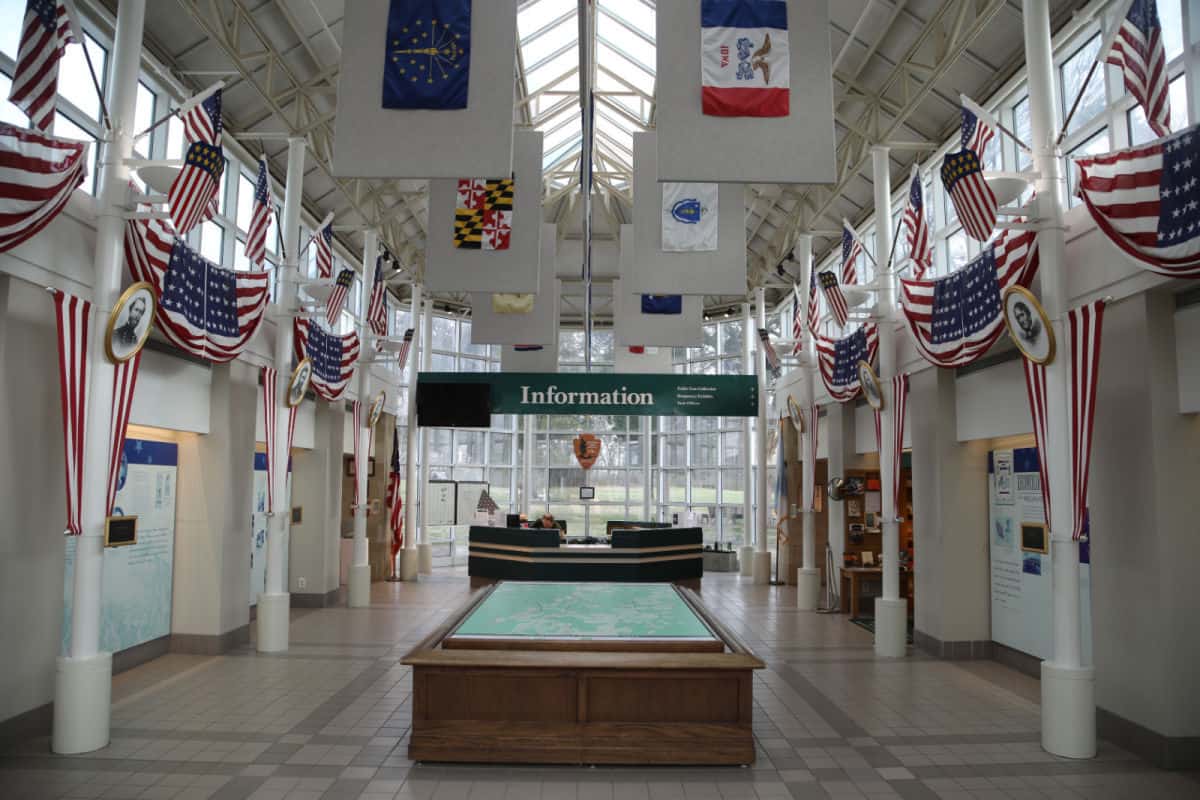
Frequently Asked Questions
How long does it take to tour the Chickamauga Battlefield?
We suggest planning a minimum of 2-3 hours to explore Chickamauga Battlefield. The time will vary greatly depending on how much time is spread reading interpretive panels and exploring each area.
Overall, plan to spend at least 2-3 hours at the Chickamauga Battlefield to get a basic understanding of the site and its significance, but those with a deeper interest in Civil War history may want to spend more time exploring the park's many exhibits and historical sites.
How much does it cost to visit Point Park in Chattanooga?
The fee is $10.00 per adult (age 16 or older). Children 15 years or younger are free.
What is a National Military Park?
A National Military Park is a National Park Service designation for parks that protect and preserve important historic sites, battlefields, and military conflicts.
Other parks with this designation include:
Fort Donelson National Battlefield - Civil War site in Tennessee
Fort McHenry National Monument and Historic Shrine - War of 1812 site in Maryland
Guilford Courthouse National Military Park - Revolutionary War site in North Carolina
Kennesaw Mountain National Battlefield Park - Civil War site in Georgia
Kings Mountain National Military Park - Revolutionary War site in South Carolina
Pea Ridge National Military Park - Civil War site in Arkansas
Shiloh National Military Park - Civil War site in Tennessee
Vicksburg National Military Park - Civil War site in Mississippi
Gettysburg National Military Park - Civil War site in Pennsylvania
How many soldiers died at the Battle of Chickamauga?
The Battle of Chickamauga was one of the bloodiest battles of the Civil War, with an estimated 34,000 casualties on both sides. The exact number of soldiers who died during the battle is difficult to determine.
16,170 Union and 18,454 Confederate casualties
Who won the Battle of Chickamauga?
The Battle of Chickamauga was won by the Confederate Army. The battle was fought from September 18-20, 1863, in northwest Georgia, near the city of Chattanooga.
The Confederate Army, led by General Braxton Bragg, was able to defeat the Union Army, led by General William Rosecrans, and force them to retreat back to Chattanooga.
The battle was one of the largest and bloodiest of the Civil War, with an estimated 34,000 casualties on both sides.
What are some of the key historical events that took place at Chickamauga and Chattanooga National Military Park?
The park commemorates several important battles of the Civil War, including the Battle of Chickamauga and the Chattanooga Campaign.
The Battle of Chickamauga, fought from September 18 to 20, 1863, was one of the largest battles of the war and resulted in a Confederate victory.
The Chattanooga Campaign, fought from November 23 to 25, 1863, was a significant Union victory that helped open the way for the Union army to march into Atlanta.
What is the best way to get around Chickamauga and Chattanooga National Military Park?
The park is best explored by car, and visitors can follow the auto tour route to see the major historical sites. However, there are also several hiking and biking trails throughout the park.
Can visitors bring bicycles to Chickamauga and Chattanooga National Military Park?
Yes, bicycles are allowed on designated trails and roads throughout the park.
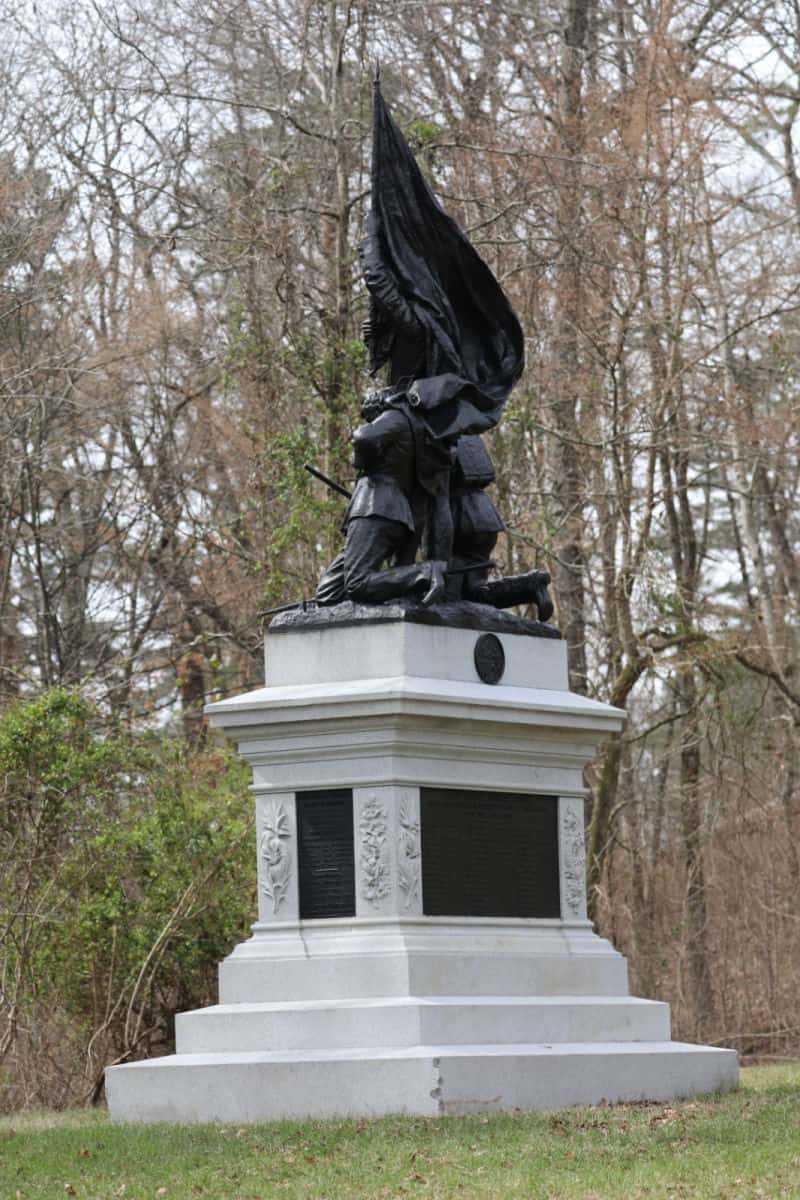
Additional Resources
Check out all the great things to do in Blue Ridge, GA on your way to the park.
Parks Near Chickamauga and Chattanooga National Military Park
Little River Canyon National Preserve
Kennesaw Mountain National Battlefield Park
Stones River National Battlefield
Carl Sandburg Home National Historic Site
Cowpens National Battlefield
Chattahoochee River National Recreation Area
Freedom Riders National Monument
Check out all of the National Parks in Georgia along with neighboring National Parks in Alabama, Florida National Parks, National Parks in North Carolina, South Carolina National Parks, and Tennessee National Parks





Leave a Reply